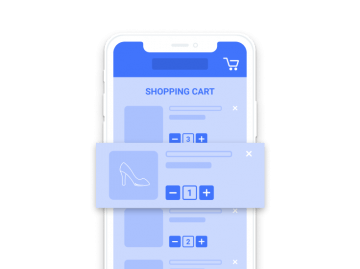There has been lots of talk about e-commerce for many years now. But now, the subject of m-commerce is coming to the fore, due to the growing popularity of people using their mobile devices to make purchases. That is why retailers face a difficult question: Is it worth investing in a native application to sell their products, or is it enough to just make their online store work with mobile devices?
To find the answer to these questions, let us look at research into market trends, the benefits of investing in an application, and the purchase process.
When customers choose an application instead of a web page
A customer visits a store in search of some missing items for their wardrobe. They find a T-shirt and trousers they like but their sizes are currently out of stock. The customer decides to find out if they can order it online so they pull out a smartphone and type the name of the store in the search engine. They do not find an application but there is a nicely built website. But they are still many steps away from completing their purchase; they must search for the items they want to buy, enter their personal data, enter their preferred payment method, choose a shipping option, and hope that they didn’t make any mistakes in the process.
The customer knows the process well. They have been through it many times and, if they have a choice, they would rather not have to do it again. The customer already has other stores’ applications installed – those apps remember their data and preferences and enables instant purchases without all of the hassle.
‘Let me check out Zalando, maybe they have the same trousers and T–shirt’ is what the customer thinks and most of the time, their hunch is correct. The customer opens a simple, fast-running application and finds what they have been looking for. They buy the same products; only from a different company than the one they first visited. The one which saves them time and effort and offers them the easiest way to meet their shopping needs.
Mobile applications: no data available means no implementation decision
Many companies see a growing need to develop a mobile application for their online store but have no data to be absolutely sure. In addition, intensive work on current operations is often more important than how the company is supposed to operate over the next five years. In addition, just the cost of producing such an application gives no incentive to speed up the discussion on the issue – companies wonder how and when the expense is going to pay for itself, if at all. However, when taking or putting off the decision, it is a good idea to do it consciously, with several aspects in mind:
- The latest global trends and statistics related to online sales,
- Notable benefits offered by a native mobile application,
- How the investment of app development pays for itself.
M-commerce as the leading trend in online trading
People are making fewer and fewer online transactions using their personal computers. According to a report by Criteo Consulting, the year-to-year decrease in the first quarter of 2018 (on the German market) was 13%, and the number of purchases made using smartphones increased by 36% in the same period. And although buying through mobile websites is still popular, the growing share of in–app purchases worldwide is clearly visible: between 2017 and 2018, there has been a 22% increase.
According to the authors of the report, in most regions of the world mobile sales account for over 50% of all online transactions, and in-app sales are dominant in this channel. This trend is particularly evident in North America and Asia, where the vast majority of customers make purchases using applications. Europe is catching up with the other regions, although mobile websites still remain just as popular as native applications. However, it can be expected that, in line with the trend and given time, apps will soon be ahead of mobile sites in Europe as well. The companies which are already developing and improving their applications will benefit the most.
According to Statista, the revenue made globally through mobile applications in 2016 was USD 88.3 billion. By 2020, that value is expected to grow to USD 188.9 billion.
Add to this the fact that people are simply using more and more mobile devices. It is easy to notice that life has largely moved to mobile, and with it, the way people shop has changed. Of course, the lion’s share of time spent in mobile applications falls to Facebook, Instagram, and other social media, but solutions such as deep linking make it possible to redirect the user from those apps straight to a selected screen in an online store application – which is already being used by market leaders.
Is m-commerce profitable?
For the customer who is a smartphone user, the answer is simple; the application is a quick and convenient solution, it allows access to the retailer’s offer from the first screen of the smartphone, it stores transaction data and automatically completes it, it collects information about shopping preferences (size, tastes, etc.) and allows for effective personalisation of the offer.
Some companies release an application and then fail to follow it up with marketing, which in turn leads to a lack of market success. A solution is a well-matched application promotion strategy which makes it possible to achieve profit and increase the competitive advantage.
Why companies invest in mobile apps:
*User convenience. Using mobile apps is no longer just a young people’s game – you can easily see the trend every day among people in their 40s and 50s as well. People are more and more used to the convenience that smartphones offer. There is also a growing awareness that the customer no longer has to click through websites (whether mobile or desktop) to buy a product – it is more convenient to do it from an application which offers more features and a number of improvements over a mobile browser. The implementation of such a solution is a response to market needs and customer expectations, which are increasingly ‘mobile’. An application is about a dozen clicks closer to such a customer. And in today’s world, that is a lot.
*Higher conversion in a native application. This phrase means that a customer who views a product in an application will be more likely to buy it than if they used the store’s website. According to the Criteo report, this conversion is over three times higher than for a mobile site! For online retailers, this means incomparably higher profits and far fewer ‘abandoned shopping carts’, that is, situations in which a customer adds a product to the shopping cart, but ultimately does not complete the transaction. What is more, with a mobile application, the shopping cart is saved for the next visit and with push notifications that can actively encourage the customer to go back to the abandoned cart again and completing the purchase.
*An additional communication channel. An application makes it possible to stay connected with the customers. The app owner can send the customer information about current special offers or new products, as well as suggest additional products to match those previously purchased: a belt for their trousers, a tripod for their digital camera, or a set of creams to go with a face mask purchased previously. Discounts on certain products can be personalized and a customer who receives this type of information becomes more loyal.
*Lower marketing costs. This subsection connects to the previous one. With a database of customers who use an application, the app owner can save on reaching the recipients through other channels. With the option of direct and free access to the current customer base, businesses can save a lot on Google or Facebook advertising (thinking in the long-term).
*More customer data. With a mobile application, businesses get to know their customers completely. This is more than standard browser cookies which remember email addresses or personal data. We are talking about customer preferences and habits, their buying history and the choices they are likely to make in the future. With such profiled data in hand, a business can offer the customer something they actually find interesting. It allows for the creation of a custom marketing message based not just on the most elementary data, but on exact preferences as well. Very specific and in-depth analytical data gathered by an application make it possible to run the business based on an equally specific strategy.
*M-commerce is an important component of the omnichannel strategy. Today, companies need to ensure a consistent experience for a customer who wants to buy something in a physical store now and online the next time. Here, the freedom to choose the form and time of purchase is key: sometimes you want to do it at the weekend at one of the shopping malls, sometimes on the way to work, browsing through offers in an app, and other times – sitting at home in the evening with a laptop or tablet. Without mobile sales, there is no real multi-channeling. And mobile is its heart.
M-commerce application – expense or investment?
Finally, many companies have to face something that they may find difficult to digest. It is the price of such an m-commerce application, which averages between USD 25,000 and USD 50,000 plus the costs related to application support and promotion. Is this a lot? If you look in terms of the money spent, then yes, it is. But there are other factors involved here which classify the purchase of a mobile application not as an expense but as an investment which pays for itself due to increased conversion, fewer ‘abandoned shopping carts’, lower marketing costs, and better customer targeting.
Thus, when planning the implementation of an application (even before generating ideas on how to stand out and impress customers), companies should define objectives and measurable results which the application is supposed to help achieve, and then identify key indicators and ways to measure them. To a business, a mobile application is like its own start-up. It requires care and continuous operation in a build-measure-learn loop.
When verifying information from the market concerning mobile applications, companies should also be aware of the negative feedback and find out why it is there. Many companies have made a lot of mistakes when developing and then managing their applications – and those mistakes resulted in a negative opinion of mobile applications as a sales channel. However, more and more of them are aware of their own responsibility for past failures and therefore take further – much more conscious and effective efforts aimed at developing their business through the mobile channel.
In the face of global changes in consumer behaviour in favour of mobile applications, there is a need to stop seeing them merely as an attractive addition to the business; something that makes you look ‘cool’. People just look for them. They expect a decent company to offer them access to its offer through every channel possible. Let’s face it: long gone are the days when having a mobile app wowed everyone and made the company look innovative. These days, a native shopping application is standard: rather than launching a browser on a smartphone and then typing the name of a company in the address bar, many people go to the Google Play or the App Store first and look for the application there. It may happen that when they type in the name of a particular company, they are not going to find it, but the names of the main competitors will certainly be there – one step closer to the customer.
You might also like

Increasing mobile app retention focuses on the users returning…

Most marketing and e-commerce experts agree that m-commerce applications…

The number of people shopping through mobile devices is…

There has been much talk of e-commerce in recent…

App Store Optimization, or ASO, entails the process of…



